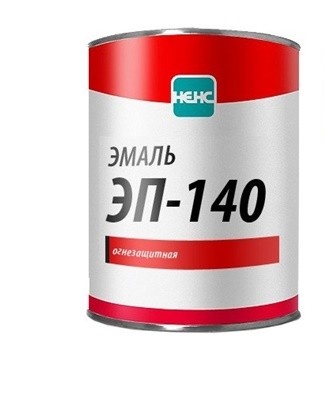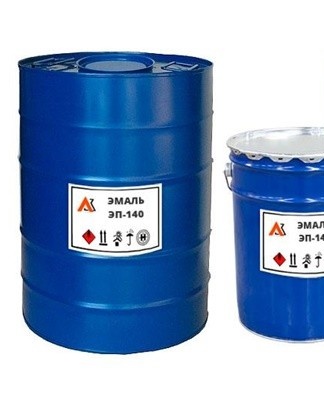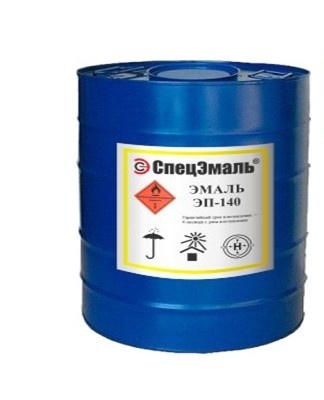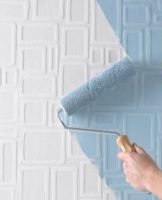Composition and technical characteristics of protective enamel EP-140, consumption per m2
Metal structures are necessarily treated with substances that protect the material from corrosion. In this case, EP-140 enamel is often used, which prevents the formation of rust for several years. This composition, according to GOST, is available in 16 shades. Along with the paint comes a hardener, without which the material does not acquire the required strength.
Spheres of enamel application
Epoxy enamel is used to protect aluminum, copper, steel, titanium and magnesium alloy structures from rust. This product is used for painting:
- Steel structures used in industrial installations. The paint is suitable for finishing both external and internal surfaces.
- Small ships. Protective enamel is distinguished by its ability to withstand the negative effects of external factors for a long time, which, together with an affordable price, made EP-140 popular in shipbuilding.
- Plane. Basically, enamel is used to paint internal parts.
- Professional equipment. In particular, enamel is used in the processing of factory machinery.
- Trains and cars. Enamel is characterized by increased resistance to the effects of substances in the composition of exhaust gases.
Paint EP-140 is distinguished against the background of similar compositions not only by its affordable price, but also by its ability to retain its original properties at high temperatures. Therefore, this composition is used in the treatment of hot pipes.
Composition and specifications
EP-140 enamel consists of two main components: epoxy resin and organic solvents. The material also contains:
- plasticizers;
- dyes;
- Other expenses.
A hardener is supplied separately with the paint, which must be mixed with the original composition to obtain a working fluid. Due to the specified composition, enamel has the following characteristics:
- resistance to various climatic conditions;
- resistance to moisture, gasoline and oils;
- creates a durable and hard protective layer;
- protects metal from corrosion;
- dries quickly;
- retains its original characteristics at temperatures up to +250 degrees.

In addition, in combination with specialized primers, enamel imparts electrical insulation properties to the treated structure. This product is distinguished by the fact that after drying it creates a layer that protects ferrous metals from the negative effects of alkaline compounds, substances containing acids and corrosive gases. Moreover, the dye acquires such properties even without preliminary priming of the surface.
Enamel is available in 16 colors. The most popular are white, black and blue. Blue, yellow, green and other shades of paint are also in demand. After application, the composition dries completely in 2-6 hours at a temperature of +20-+90 degrees. The concentration of non-volatile substances in the paint reaches 34-61%.
After mixing the original composition with the hardener, the enamel retains its original properties for six hours, provided that the ambient temperature does not exceed +20 degrees. That is, during this time, the composition should be applied to the surface. To modify the viscosity, EP-140 is mixed with R-5A solvent. With this tool you can get a working fluid suitable for spraying from a spray gun.
Rules for applying paint
In order for the enamel to acquire the desired properties, it is necessary to carefully prepare the surface. This will require:
- remove traces of rust;
- clean the surface from dirt;
- remove old paint;
- degrease the structure.

It is also important to properly prepare the enamel by following the enclosed instructions. It is recommended to mix the initial composition with the hardener for at least 10 minutes, until the paint acquires a uniform consistency. Prepared surfaces can be treated by applying the enamel by brush, roller or spray gun. It is also possible to spray the structure with paint from a container.
When processing metal structures, it is recommended to apply at least two layers. After each staining, you have to wait more than five hours at temperatures above +20 degrees so that the enamel has time to dry. In some cases, it is allowed to expose the composition to heating. This speeds up the drying process.
How to calculate consumption per 1 m2
Dye consumption depends on both the area of application and the type of material used. This parameter is usually indicated on the packaging.On average, up to 65-85 grams of paint per square meter of surface are used, provided that the mixture is applied in one layer.
Storage rules and periods
The dye contains solvents and other components that ignite on contact with open fire, releasing toxic substances into the air. Therefore, the composition should be stored and applied away from:
- foodstuffs;
- where humans and animals live;
- open fire sources.
It is recommended to store the material in a tightly closed container, away from direct sunlight and moisture. Under these conditions, the dye retains its original properties for a year after production.

Precautionary measures
When painting surfaces with EP-140 enamel, it is recommended to wear rubber gloves, since the material can cause an allergic reaction when in contact with the skin. It is also recommended to carry out the work in a ventilated place. After painting, leave the piece out in the open while the enamel dries.
Analogs
You can replace the EP-140 enamel with:
- EP-5287;
- KO-84;
- Emacout 5311;
- "EMACOR 1236";
- EP-12364
- EP-773.
These materials are also epoxy resin based. The similarity between these products comes down to the fact that each of the listed dyes protects metal structures from rust. However, the rest of the properties of the given compositions differ from each other.
Comments
Andrey, Moscow:
“We finished the garage doors with EP-140 enamel. A year later the paint has not chipped, faded or peeled. No traces of rust or other defects were found during the inspection of the door."
Anatoly, Nizhny Novgorod:
“We tried different paints in production. But only this one was at its best. Several months after painting, machines constantly in contact with water or oils retain their original color. The paint showed itself on the good side, demonstrating high wear resistance. "
Maxim, Voronezh:
“I first tried EP-140 to paint the gate in front of the house. Then, when I noticed that a year later and after a long winter the paint was not peeling, I tried enamel on other metal structures. During the operation, I did not notice any defect."



